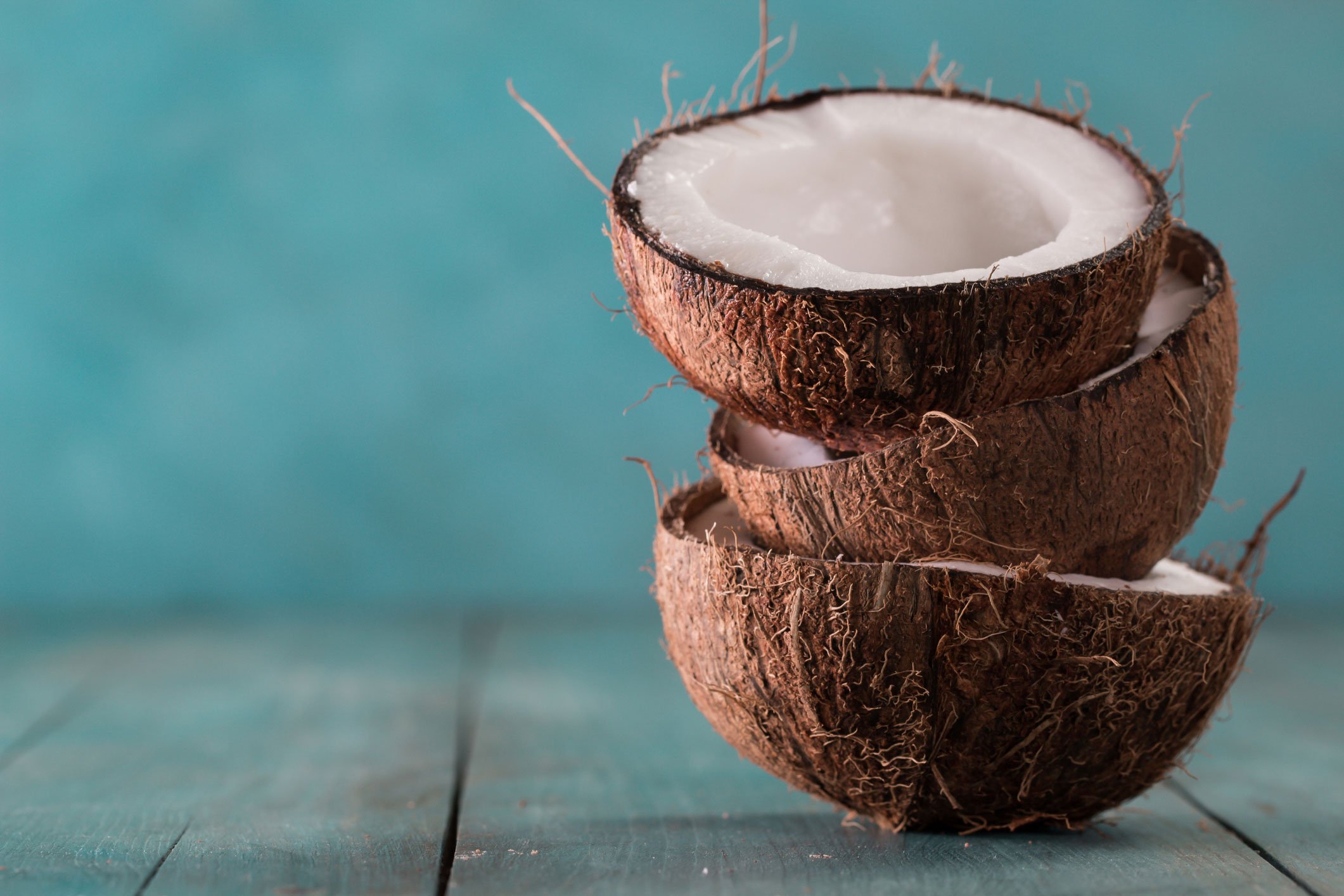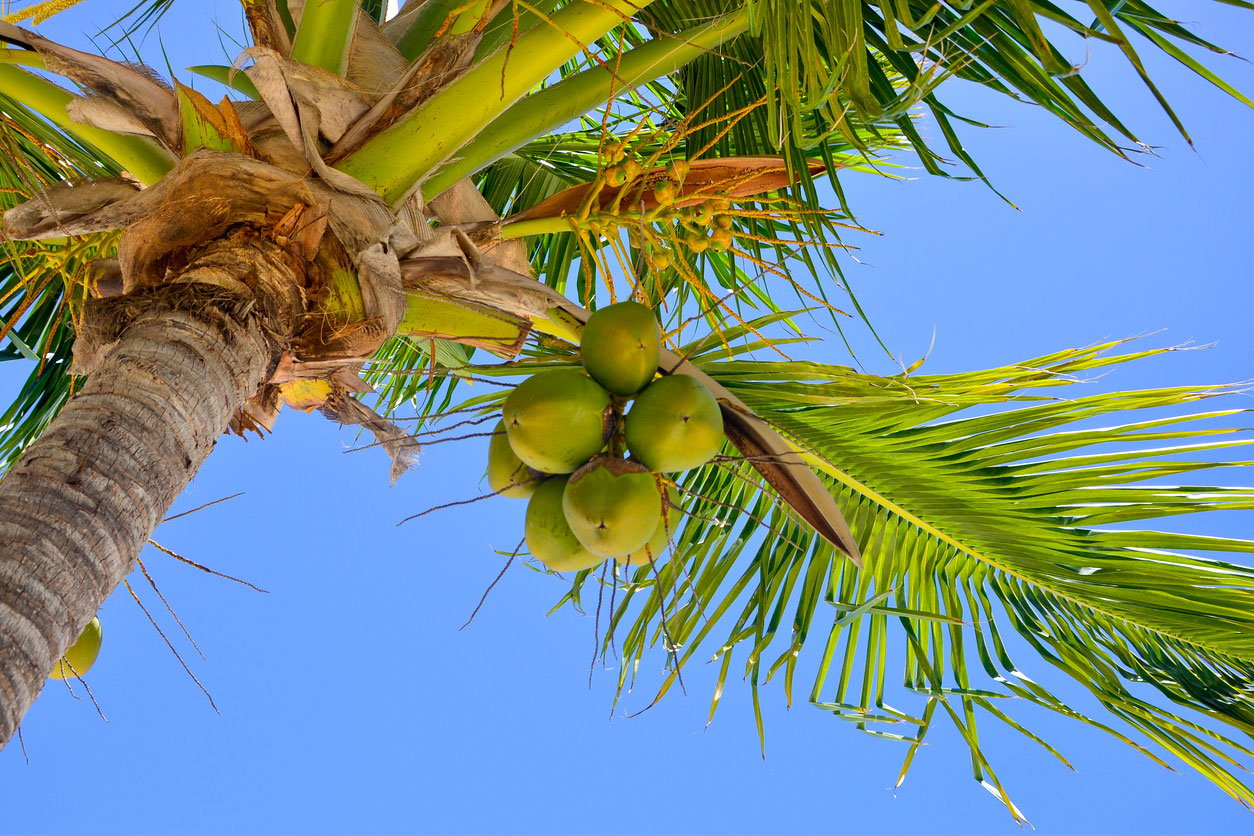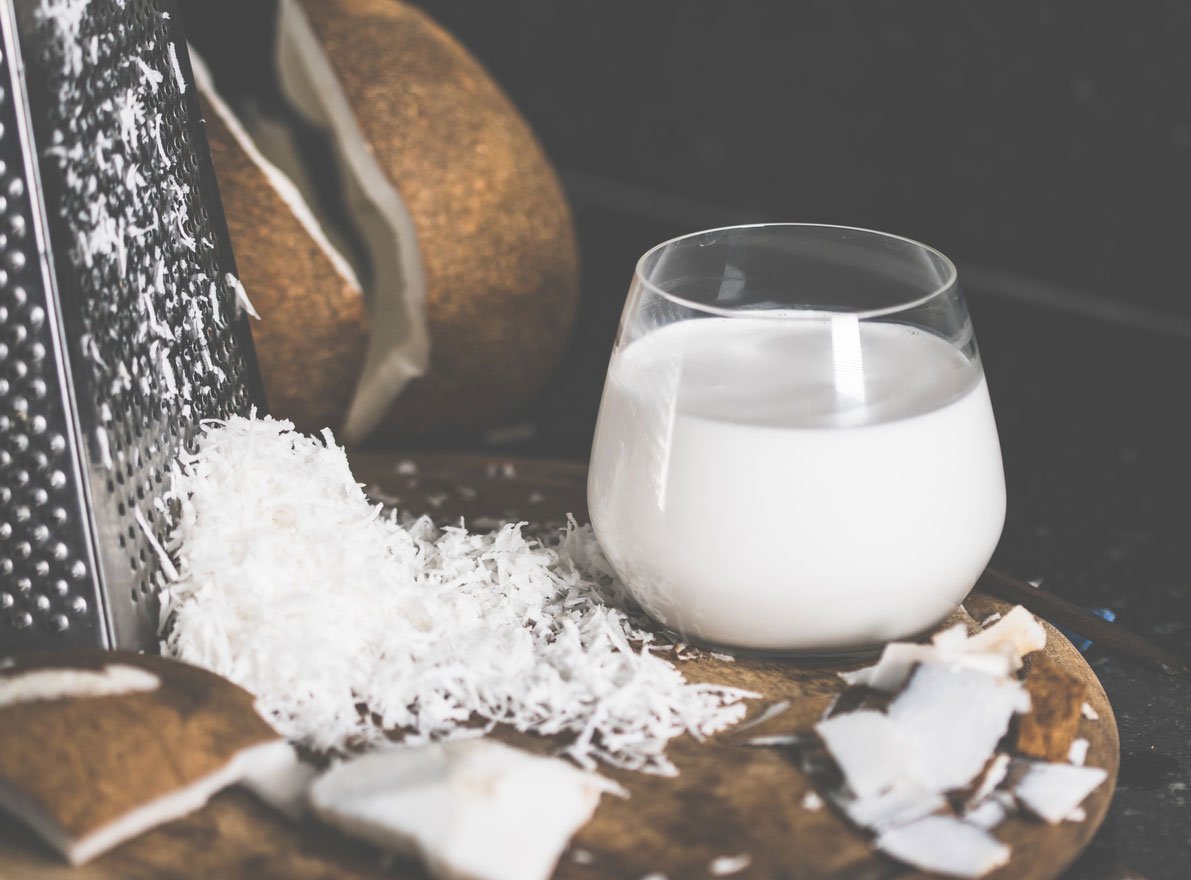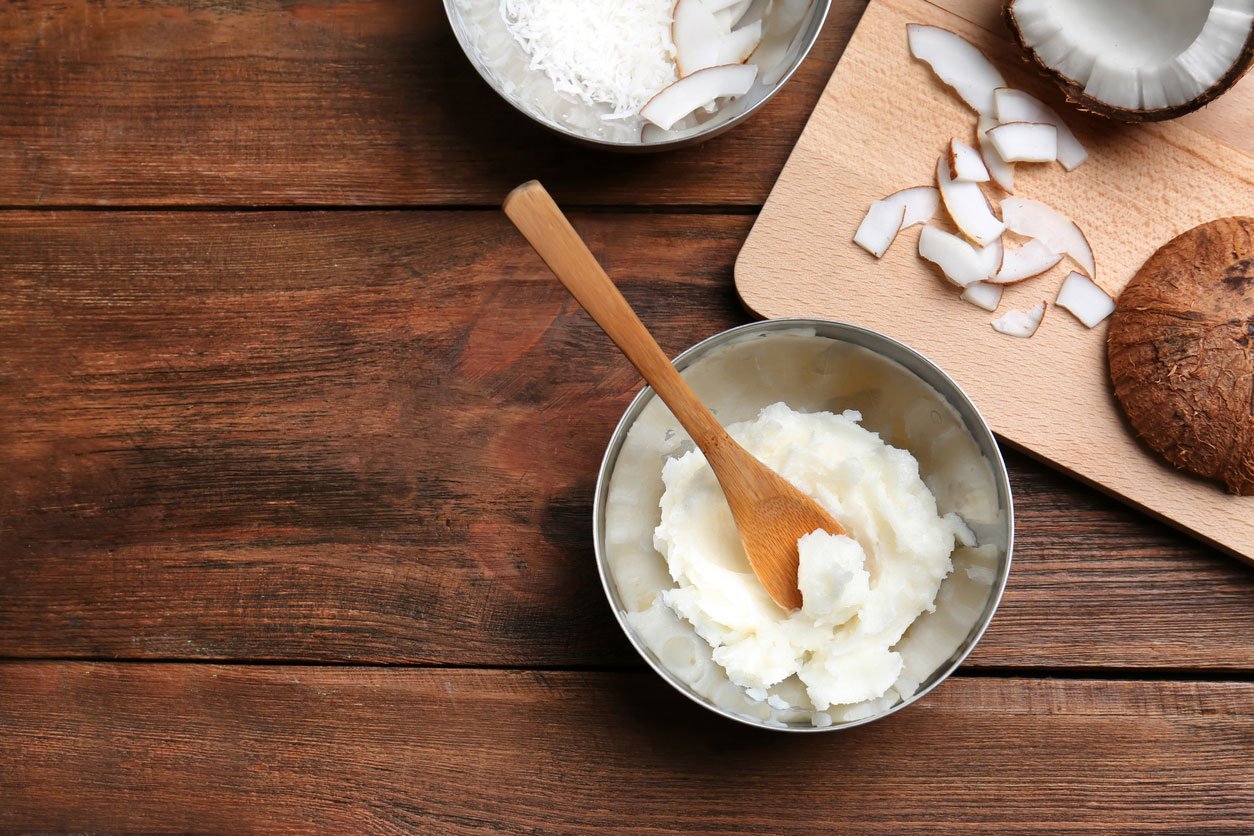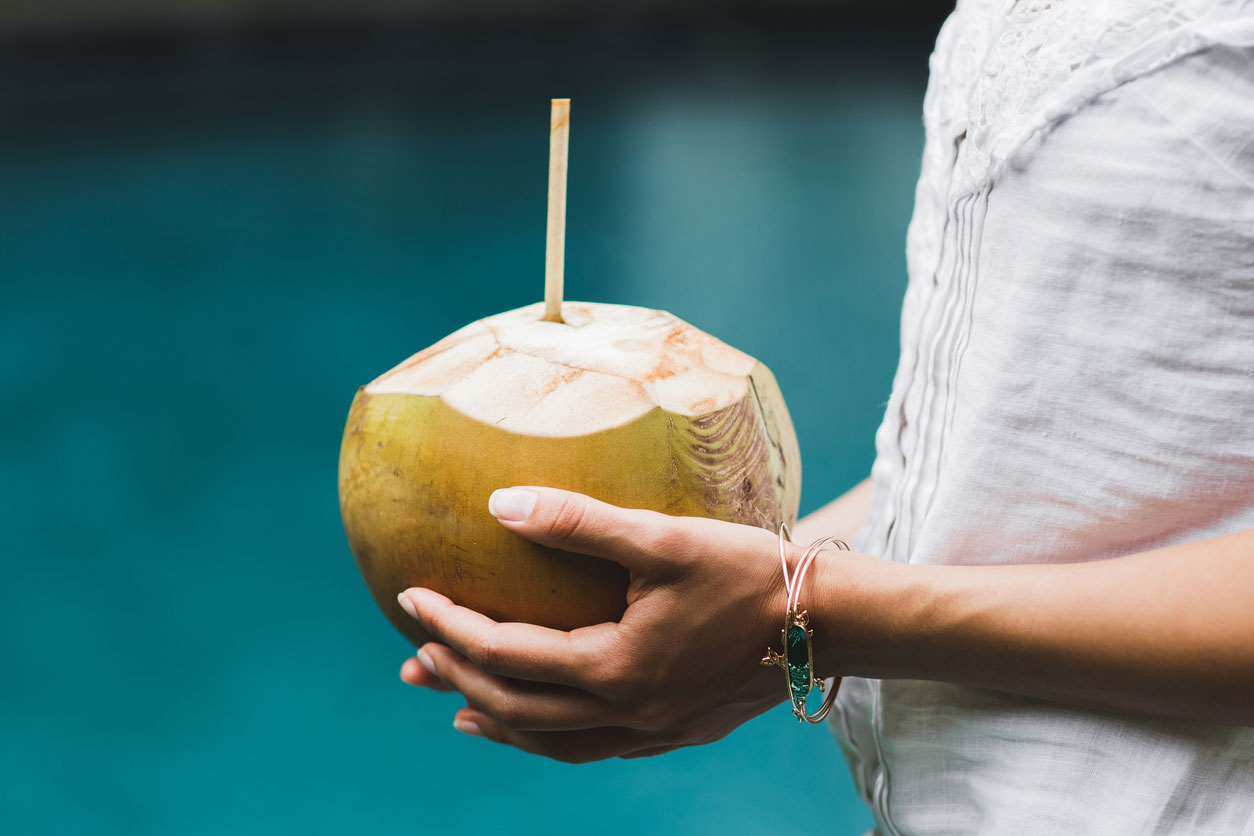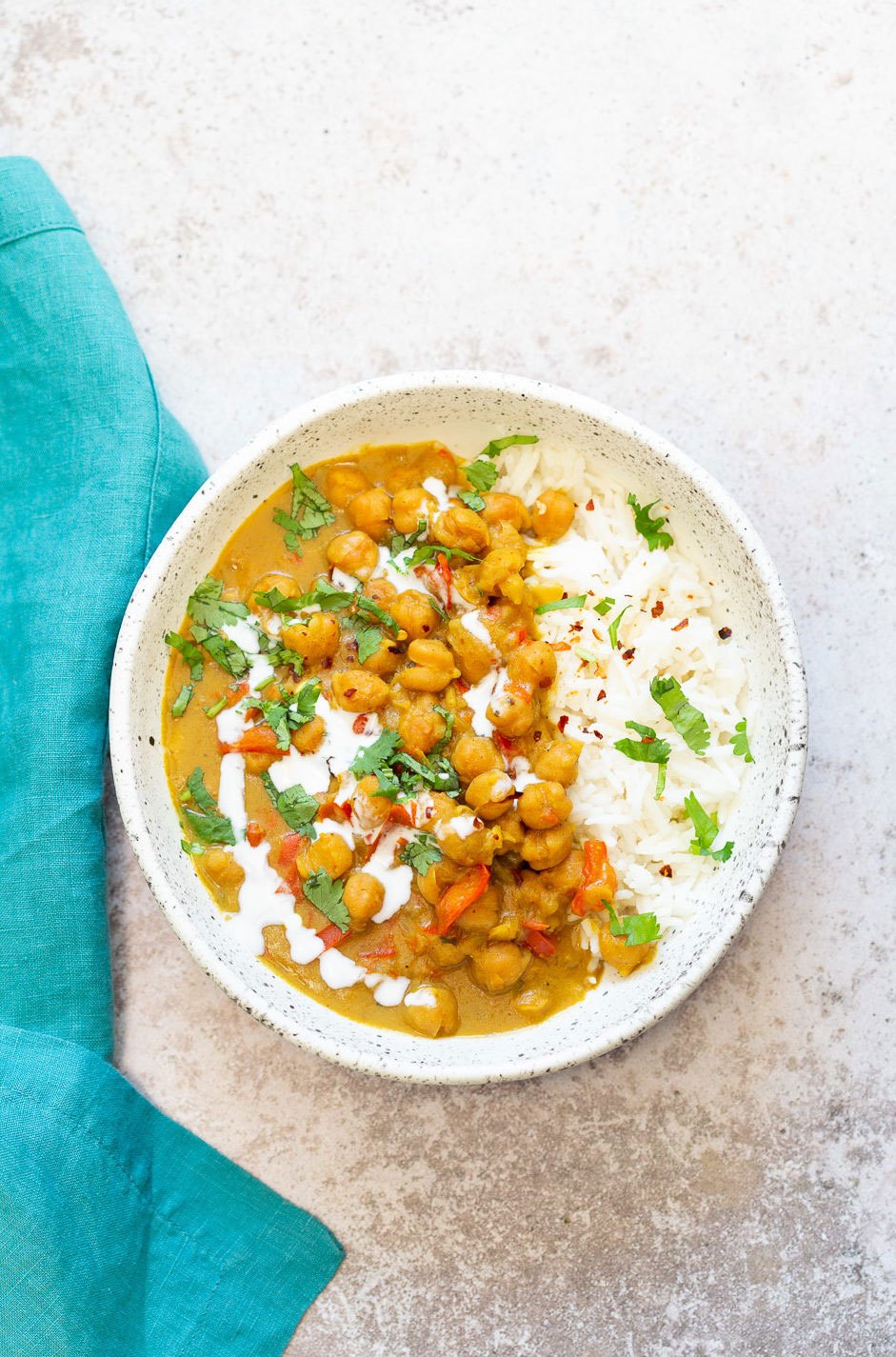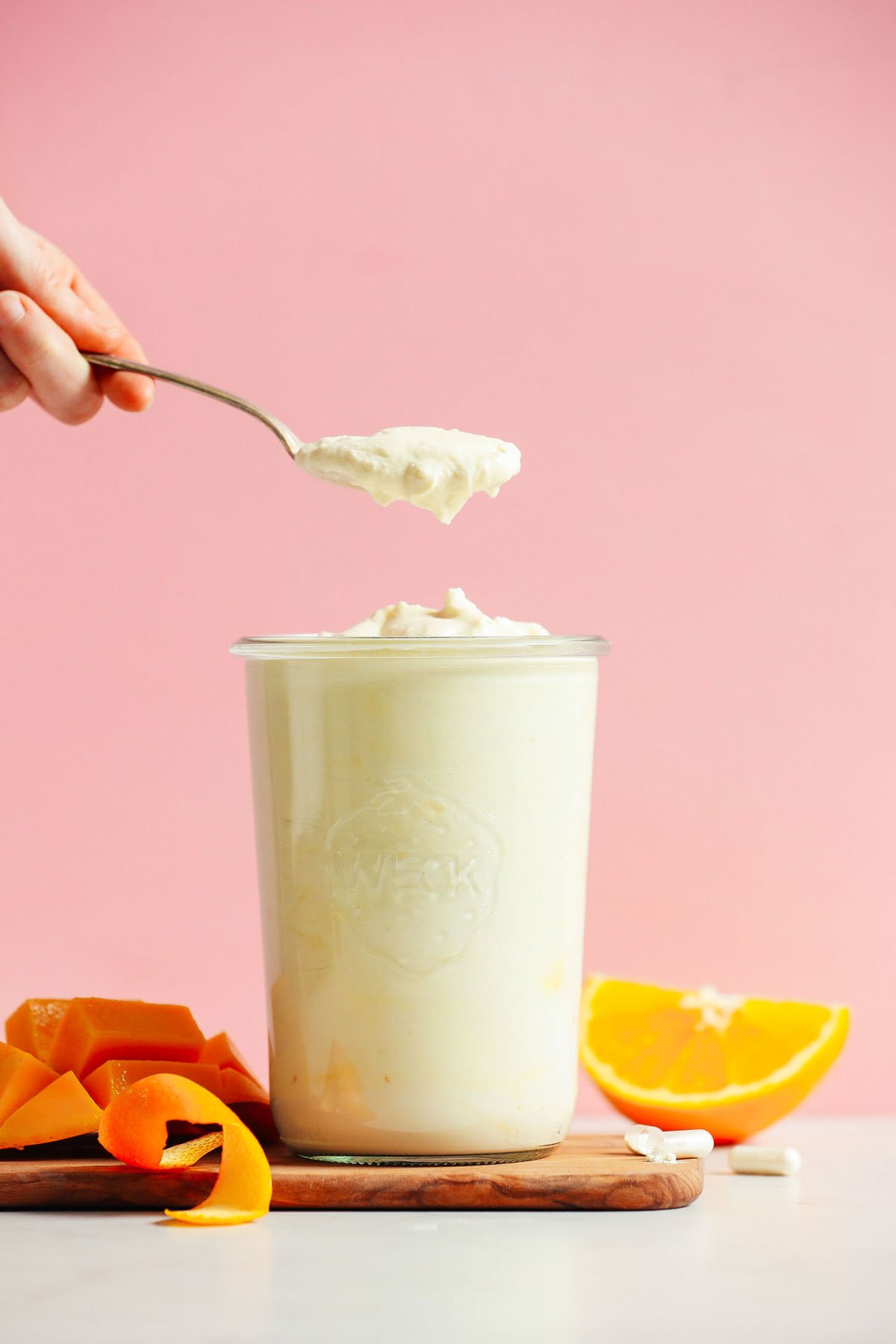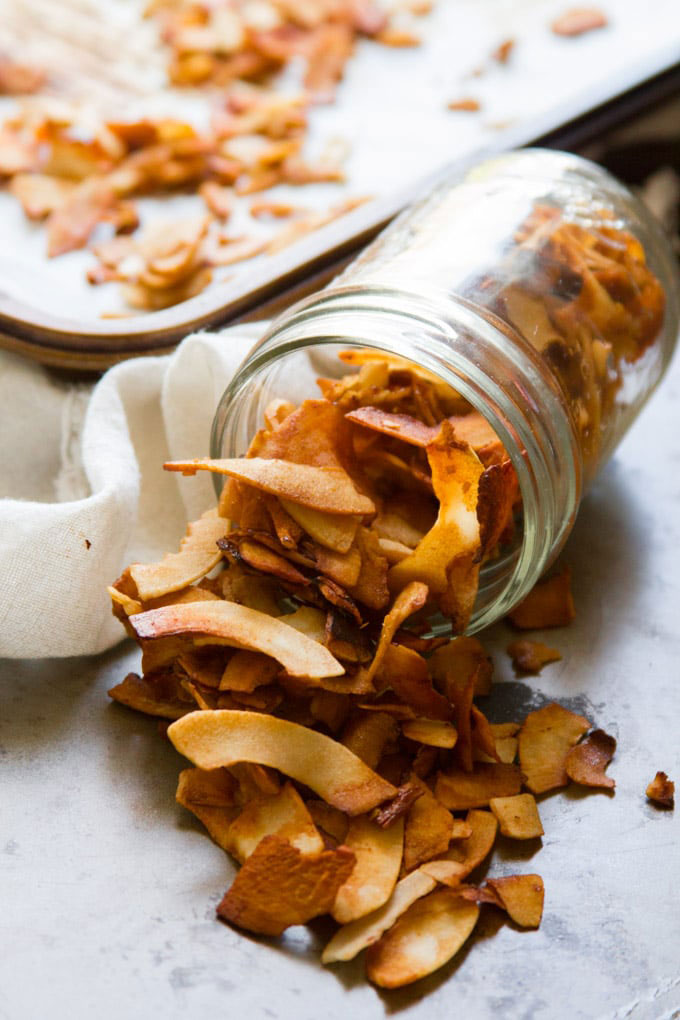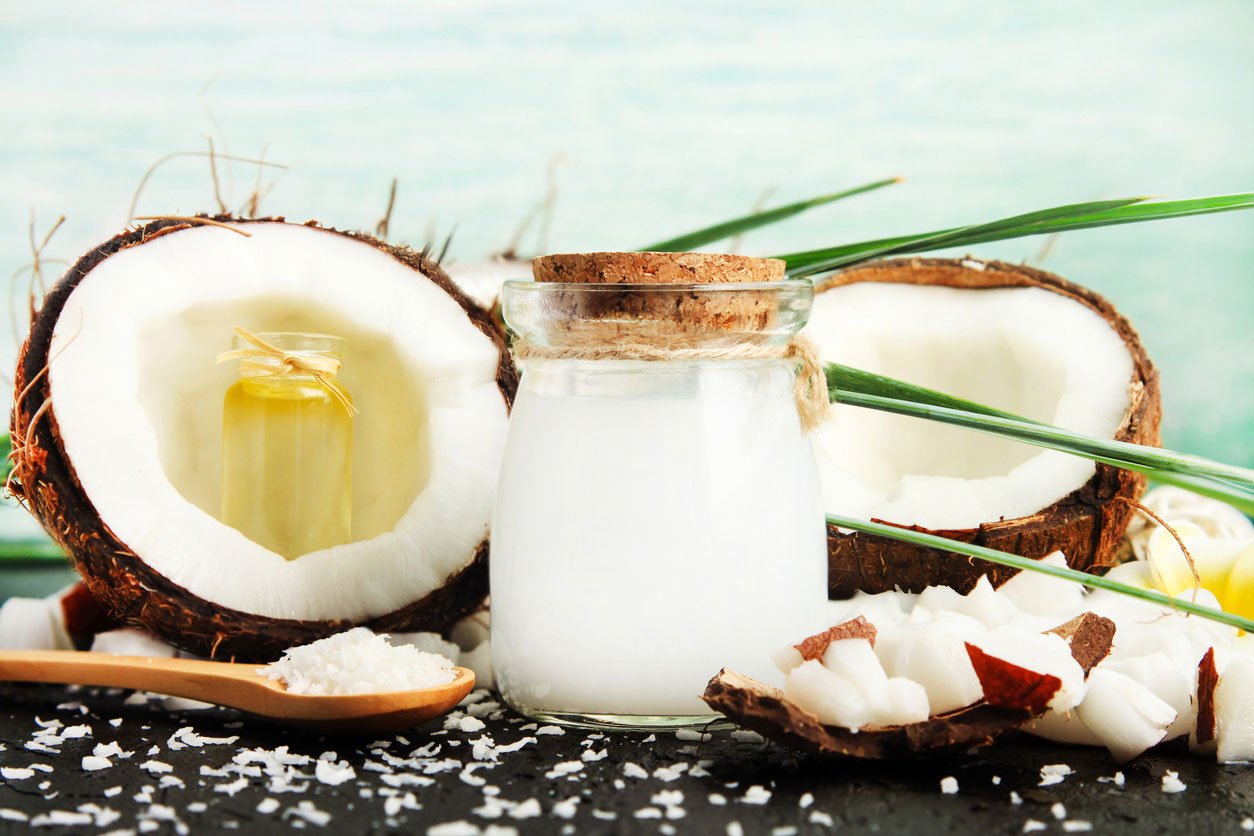Coconuts grow on beautiful trees. They’ve had songs written about them (“I’ve Got a Lovely Bunch of Coconuts,” anyone?), and we’ve been consuming coconut products for a long time, from candy bars to creamy Thai soups. But it’s only recently that they’ve taken the world by storm. From oil to water to personal care products, the humble coconut has become somewhat of a celebrity in the plant world and coconut health benefits are on the rise.
But it’s a controversial celebrity, with as many detractors as cheerleaders. There’s a raging debate about whether coconut is good for you or bad for you due to the nutritional benefits and harms of various coconut products. And there are reasons to be concerned about the ethical and environmental impacts of the global coconut trade, too. So is coconut healthy for people or the planet?
What are Coconuts, and Where Do They Come From?
A coconut is a fibrous, one-seed drupe (a strange word that means a fruit with a hard kernel inside, like a plum or a peach), but can actually be considered a fruit, a nut, and a seed all at the same time.
There are two original species of coconut: the Pacific Ocean coconut and the Indian Ocean species. One coconut type that grows in Madagascar and the Comoros Islands is actually a genetic mixture of those two species. There are also tall and dwarf coconut varieties from Polynesia, called niu kafa and niu vai fruit, respectively. Dwarf coconuts are small, as their name indicates, and make up only 5% of the world’s coconuts.
Coconut Uses
Coconuts take a year to fully mature and ripen, but they can be eaten anytime after about seven months. Young coconuts are green, and their meat is soft and can be sweet. Most coconut water comes from young coconuts. As they get older, coconuts begin to turn brown, and the meat inside thickens, hardens, and develops its high-fat content. Most coconut milk, coconut oil, and coconut cream products are made by grinding up the flesh of mature coconuts and then processing it in a variety of ways.
Many stores sell two kinds of coconut milk: the canned variety, which is very thick and calorically dense, and a heavily watered-down version that’s an alternative to cow’s milk. For the sake of clarity, this article will refer to the thicker kind of coconut milk.
You can use every part of the coconut plant. The flesh can be used for meat, milk, or oil; the water for hydration. And the husk, shell, leaves, and trunk can be used for everything from mosquito coils to activated carbon water filters, and from roofing material to ropes. It’s because of this that the coconut is called the “Tree of Life” in the Philippines and the “tree of a thousand uses” in the Malay language (in case you’re wondering what it sounds like in Malay, it’s “pokok seribu guna”).
Coconut Nutrition
Coconut meat is a high-calorie and fat-rich food, with nearly 300 calories and 30 grams of fat per cup. You can press some of it to make coconut oil, coconut milk, and coconut water. The fibers in coconut husk can be spun into rope called sennit, and the shell can be turned into charcoal.
There are claims that one of the benefits of coconut water was hydration in the form of IV fluid during shortages during World War II. But the evidence for this is not well documented. There is one documented case where coconut water was used successfully as IV fluid in a patient in a remote area of the Solomon Islands. While coconut water is high in electrolytes like potassium, most physicians would prefer to use it as an oral rehydration therapy rather than intravenously.
Coconut milk and cream are often canned, while the cream is sometimes found in the frozen food section. The milk is made by heating equal parts shredded coconut meat with water, whereas the cream is much thicker and made by heating four parts coconut meat to one part water.
One cup of coconut milk contains 75 calories, 0.5 grams of protein, and five grams of (mostly saturated) fat, and is high in calcium. A mere ¼ cup of coconut cream contains 120 calories, one gram of protein, and 12 grams of fat, eight of which are saturated. Both coconut milk and coconut cream often include guar gum or other additives, which might not be great for you, but these are generally unnecessary. And there are usually additive-free options available.
Coconut oil is made by blending coconut meat, separating the water from the cream, and processing the cream into oil. Coconut oil is 100% fat — 80-90% of which is saturated fat.
Is Coconut Healthy?
The health effects of coconut meat are the subject of debate. On the one hand, it’s extremely dense in calories. This means it’s easy to eat hundreds or even thousands of calories of coconut meat without feeling full, which can lead to weight gain. And even more controversially, it’s extremely high in saturated fat. Most medical, scientific, heart-health, governmental, and professional authorities agree that saturated fat is a risk factor for cardiovascular disease. This includes the World Health Organization, the Academy of Nutrition and Dietetics, the Association of U.K. Dietitians, the American Heart Association, and the European Food Safety Authority.
But hold on. There’s a plot twist. It turns out that coconut contains a different mix of saturated fat types than those found in animal products, with the potential for different effects. In fact, some research suggests that coconut meat might even have some benefits for heart health.
In some parts of the world, coconut has traditionally provided the main source of dietary fat, while rates of adverse health conditions like coronary artery disease were low. One example is the Marshallese people on the Marshall Islands. They traditionally ate a diet that derived most of its total calories from coconut and coconut products. As recently as 70 years ago, there was no diabetes and very little other chronic diseases among them. Since World War II, the Marshallese began to adopt a more Western diet, eating fewer coconuts, fruits, and fish, and eating more white flour, sugar, and dairy products. Tragically, their rates of obesity, diabetes, and other chronic illnesses have skyrocketed.
What we still don’t know is whether the coconuts were healthy in their own right, or simply far healthier than what the Marshallese are eating today. Comparing the health effects of a dietary pattern to the modern Western diet is a bit like comparing the gas mileage of a car to that of a gas-guzzling semi-truck that’s stuck in first gear. Almost anything natural will be healthier than a diet based on soda and Cheez Whiz.
Health Benefits of Coconut
So what does more modern research tell us about whether coconut is healthy?
In a 2013 study published in the Journal of Nutrition and Metabolism, 60 healthy participants ages 18-57 received oatmeal made with coconut milk five days per week for eight weeks. After a two-week break, they then had oatmeal made with soy milk for the same period. The researchers measured cholesterol levels after each intervention, finding that coconut milk raised HDL “good” cholesterol and lowered LDL “bad” cholesterol in statistically significant amounts, compared to soy milk.
This is particularly striking because the U.S. Food and Drug Administration began allowing soy products to carry claims about heart benefits starting in 1999, primarily due to soy’s ability to improve cholesterol levels.
Coconut meat may also contain compounds that help regulate blood sugar. A cruel sounding 2011 animal study published in the journal Chemico-biological Interactions found that diabetes-induced rats fed coconut kernel protein experienced an improvement in diabetes-related pancreatic damage, compared to the control group. The researchers concluded that this was likely a result of the ability of the amino acid arginine in coconut to promote regeneration of pancreatic beta cells, which produce insulin.
Coconut Water
And let’s not forget about coconut water, which in addition to being delicious, is also very high in potassium. Having the right potassium to sodium balance is important for hydration and for optimal health. Most people in the modern world are vastly out of balance — getting far more sodium than potassium in their diets. How lovely, then, that a cup of coconut water provides 600 mg of potassium (and almost no sodium).
In addition, there is documentation of coconut water being effective in the rehydration of people with severe gastroenteritis, or the inflammation of their digestive lining, which can make it difficult to eat or drink.
There may also be anti-inflammatory compounds found specifically in coconut water. In one ethically dubious 2016 animal study, rats with paw swelling were either given oral distilled water, coconut water from young coconuts, coconut water from mature coconuts, or an injected ibuprofen mixture. The researchers found that young coconut water had the strongest anti-inflammatory effect, while mature coconut water had a milder, but still impactful anti-inflammatory effect. Remarkably, the study found that young coconut water has stronger anti-inflammatory power than ibuprofen, a drug that is frequently prescribed specifically for its anti-inflammatory effect.
Is Coconut Oil Good For You?
Coconut oil is especially popular right now and has been hailed as somewhat of a “miracle cure” for a variety of conditions. Some of these include Alzheimer’s and other dementias, cancer, diabetes, digestive conditions, high blood pressure, AIDS, herpes, kidney disease, Parkinson’s disease, and pretty much any other serious illness you may be facing. If you Google “coconut oil,” much of the internet’s conversation around the topic has to do with whether it’s healthy and therapeutic. In fact, the first two questions posed in Google’s “People also asked” feature were, when I searched, “What is coconut oil good for?” and “Why is coconut oil bad for you?” Talk about mixed messages! While stories and testimonials abound, what’s largely missing is scientifically rigorous evidence.
So is coconut oil healthy? Coconut oil is 100% fat, the majority of which, as we’ve seen, is saturated. But while the scientific consensus developed over the past 70 years has been that saturated fat is bad, the truth turns out to be a bit more complicated. There are numerous kinds of saturated fat, each of which has a different effect on your body. Depending on the length of their carbon chains, various saturated fatty acids have very different effects on human health.
Lauric Acid
For example, lauric acid, which makes up about half the fat in coconut oil, has been shown to favorably alter the ratio of HDL (“good”) cholesterol to total cholesterol. While lauric acid does raise total cholesterol, it raises HDL cholesterol to a greater extent than LDL. This means it favorably alters the ratio of HDL to total cholesterol. It’s unclear what effect this may have on heart health and longevity. But at least, based on lab results, it could be a positive step. (For more on cholesterol, read this article.)
Lauric acid converts to a compound called monolaurin in the body, which may have antiviral, antifungal, and antiseptic properties. It’s for this reason that many people have tried “oil pulling,” or the process of swishing and spitting out coconut oil for oral hygiene.
MCTs
Coconut oil is also a source of medium-chain triglycerides (MCTs), which may have health benefits like supporting healthy weight loss, brain function, and insulin sensitivity. However, the benefits of the MCT oil in coconut may be overblown because many of the studies showing benefit from the use of MCTs were based on 100% MCT oil. In contrast, coconut oil contains only around 14% MCTs.
But although lauric acid and MCTs may have some health benefits, the fact remains that a tablespoon of coconut oil contains 12 grams of overall saturated fat. The American Heart Association recommends you eat less than 13 grams of saturated fat per day (from all sources). That’s the primary reason that most health professionals do not recommend coconut oil as a health food.
Coconut is delicious, useful, and potentially nutritious. But coconut oil is highly processed, and it may be the least healthy way to consume coconuts: Many of the compounds in coconut and coconut products that are responsible for its health benefits, including most of its flavonoids, antioxidants, sterols, stanols, and phytochemicals, are largely eliminated in the manufacturing of coconut oil.
You’ll find two main types of coconut oil in stores: refined and unrefined. Refined coconut oil has been bleached of its color and deodorized. Often, sodium hydroxide is added to increase its shelf life. A typical part of the manufacturing process for refined coconut oil is to use chemical solvents to extract the oil. The only advantage of refined versus unrefined coconut oil is that it cooks at very high temperatures, with a smoke point of 450°F (232°C), whereas unrefined coconut oil has a smoke point of 350°F (175°C). Refined coconut oil has a milder taste than unrefined.
Other Uses of Coconut Oil
Besides being a kitchen staple, coconut oil does have some great personal care benefits. Coconut oil is very rehydrating and has uses as a lip balm, a skin and hair moisturizer, a lubricant, a remedy for diaper rash, and even as a shaving cream. It also has uses as a makeup remover. Natural soap makers favor coconut oil as a main ingredient, as it produces a hard bar that lathers well without requiring laurel and laureth sulfate as foaming agents.
Are Coconuts Ethical Or Sustainable?
The global demand for coconut has been rising fast. And Allied Market Research projects that this trend will continue, with global sales exceeding $31 billion by 2026.
Coconut trees live for about 100 years, but they reach their peak production (as many as 400 coconuts per year) between 10 and 30 years of age. Global demand for these products is growing at more than 10% annually. But the present rate of production growth is only 2% per year. This is driving up prices for all things coconut. Unfortunately, little of that money reaches the farmers who grow the coconuts.
Most coconut farmers in Southeast Asia are living in poverty, often earning less than $1 per day. The world demand for coconut centers on value-added products such as virgin coconut oil, coconut water, and activated carbon filtration elements, not the raw nuts. The processors, distributors, marketers, and retailers receive roughly 89 cents of every dollar spent on these coconut products, while the farmers end up with a meager 11 cents. Without enough income to invest back into what they’re growing, many farmers cannot adequately protect their coconut crops against things like pests, inclement weather, and environmental destruction, or investing in long-term sustainability.
Coconut Cultivation Can Be Problematic
Because of the increasing popularity of coconut products, the cultivation of coconut palms for coconuts is a leading cause of deforestation in the tropics. Areas that were previously forested are now occupied by coconut palms, leaving less and less land area for forests.
And with deforestation also comes an impact on biodiversity, especially because many island nations have unique species that developed in isolation. When these species’ habitats are disturbed by deforestation and other human interventions, they are at greater risk for endangerment and extinction. In fact, a study published in July of 2020 found that coconut product cultivation threatens more species than olive, oil palm, soybean, groundnut, sunflower, and rapeseed combined. Coconut plantations were responsible for the extinction of the Ontong Java flying fox in the Solomon Islands, and currently threaten 66 different species in multiple countries.
A small but growing number of coconut farmers are working with Fair Trade USA, which seeks to create a better situation for farmers as well as the environment. This entails using fewer pesticides and promoting more biodiversity among crops. It also puts money back into disaster relief programs, tree replanting, and community development. If you’re going to purchase coconut products, and you care how they’re grown, and the impact they have on farmers and the environment, purchasing Fair Trade Certified products is a good place to start. You can look for the Fair Trade logo on the packages of coconut products.
Should You Buy Organic?
How important is it to buy organic coconuts? The answer is, it depends. If you like to purchase all organic produce, there certainly are organic coconuts and coconut products available. However, studies have shown that coconuts are not at high risk for showing up on Environmdntal Working Group’s Dirty Dozen list of the most pesticide contaminated foods anytime soon. In fact, testing for pesticides on coconut products has come out with little to report. It probably helps that nobody is taking a bite directly out of the coconut husk. A 2002 study looked for 11 pesticides in 15 samples of coconut water and found no detectable levels. And a 2016 study analyzed 36 samples of coconut pulp and water for 10 pesticides, finding only four present, but in unquantifiable amounts.
But if a coconut isn’t organic, this means that it was likely grown with chemical pesticides and fertilizers – with all of the corresponding environmental impact. So even if the pesticide residues aren’t detectable in your food, there are still some good environmental reasons to go organic. And many of the fresh eating coconuts (the soft ones with meat you can scoop with a spoon) are treated with post harvest bleaching agents, fungicides and preservatives to help them survive boat trip to the US or Europe and still arrive with weeks of shelf-life. I’m not aware of any research showing residues making their way inside, but it’s something to be aware of.
How to Eat Coconut
While most coconut in non-tropical areas is purchased from the store in the form of oil or has been shredded, dried, or canned, you might be able to find whole coconuts throughout the year too. Often Asian and specialty markets carry young coconuts, which are a common staple for many raw food lovers.
The coconut’s characteristics change depending on its age. Young coconuts contain more water, while mature coconuts contain more meat. Young coconut meat tends to be mild-flavored and rubbery, while mature coconut meat is more flavorful, thick, and fibrous. On the outside, young coconut is typically white and angular without a husk. A mature coconut, on the other hand, will be round and have its brown, fibrous outer shell still intact.
The main components you’ll get from a raw coconut include its meat and its water. Some of the best uses include:
- Eating it with a spoon (or your hands!)
- Creamy sauces, like curry or a vegan mac and cheese sauce
- Baked goods, like moist cakes and fragrant desserts
- Beverages, such as mocktails, smoothies, coconut milk lattes, and golden milk made with turmeric
- Soups with a thick base
- In stir-fries
But when you first purchase a raw coconut, the first step is to open it. You can use a hammer and a rock, of course, but there are easier and safer methods (no, don’t run it over with your car!). Here’s a great tutorial for how to open a coconut:
https://www.youtube.com/watch?v=qG1TixLC3oI
7 Refreshing Coconut Recipes
Here are some tasty recipes using coconut in every angle, from entrees to snacks, desserts, and even beverages.
Chickpea Coconut Curry by Vegan Richa
This is a one-pot recipe that melds together coconut milk with warm spices and veggies in a saucepan or Instant Pot.
Vegan Tom Kha Gai (Thai Coconut Soup) by Cook with Manali
This is a spicy, sweet, tangy soup made with coconut milk, veggies, and cilantro.
Mango Coconut Yogurt by Minimalist Baker
Here’s a fun and delicious way to make your own creamy yogurt at home, using coconut milk, mangos, orange juice, vanilla, and probiotic capsules.
Coconut Bacon by Connoisseurus Veg
Most of what people like about traditional bacon is replicated in this recipe, which entails flavoring and baking coconut flakes to create a smoky, crispy, delicious end result that you add to pasta, on sandwiches, or eat alone.
Vegan Ceviche Tostadas by Hot for Food by Lauren Toyota
These tostadas stack young coconut meat, black beans, avocado, squash, and onion, layered with cashew cream, to create a filling and tasty plate.
Coconut Pomegranate Mojito Mocktail by Jessica Spiro Nutrition
This fun recipe uses aromatic and flavor coconut water and pomegranate arils to create a nutrient-rich, sugar- and alcohol-free mocktail.
Vegan Coconut Cups by ElaVegan
Here’s a plant-based, gluten-free, and refined sugar-free recipe that combines coconut, cocoa, and dates to make a delectable dessert.
Should You Eat Coconut?
Studies show us that that coconut offers a number of health benefits, but not all parts and forms of coconut have the same health impact. It matters how or if it’s been processed, which parts you’re eating, and where and how it was grown. And there are some people, especially those with heart disease, who should probably steer clear of coconut milk, cream, and oil altogether. And, of course, if ever you purchase coconut products, supporting Fair Trade Certified farmers is a positive investment in farmers, soil, and the world we share.
Tell us in the comments:
- What do you think?
- Do you eat coconut? If so, in what forms?
- Do you eat coconut oil?
Feature image: iStock.com/id-art
